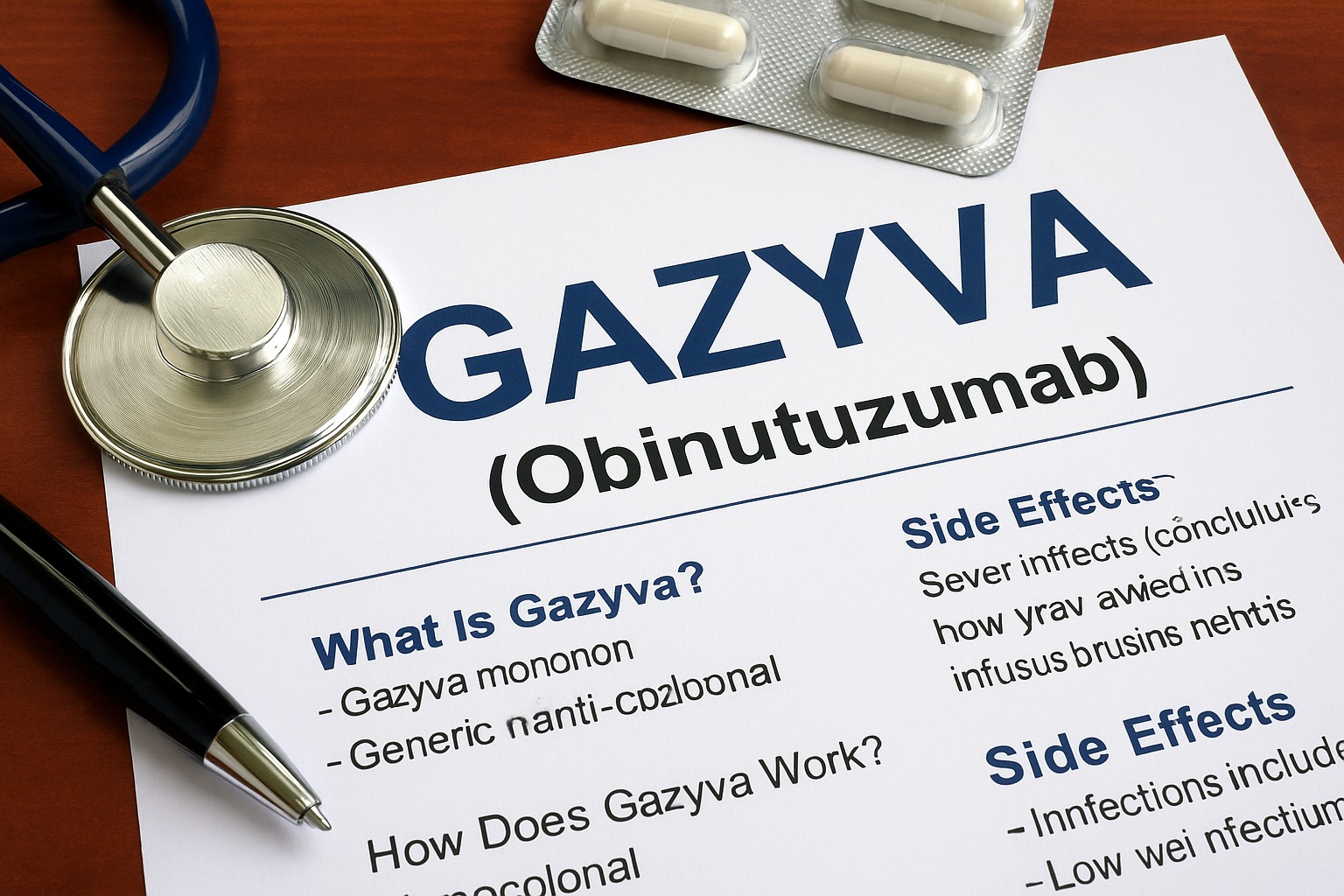Gazyva is a prescription medicine used to treat certain blood cancers and autoimmune conditions. Its active ingredient, obinutuzumab, is a monoclonal antibody that works by attaching to CD20 proteins on B-cells (a type of white blood cell), helping the immune system target and destroy them. By lowering abnormal or overactive B-cells, Gazyva helps control diseases like leukemia, lymphoma, and lupus nephritis.
Doctors prescribe Gazyva in combination with other medicines or alone, depending on your diagnosis and treatment plan. It is given as an intravenous (IV) infusion in a clinic, not at home.
In this simple guide, you’ll learn what Gazyva is, how it works, when doctors prescribe it, how it’s given, possible side effects, safety tips, and answers to frequently searched questions (dosing, infusion schedule, manufacturer, price, and more).
Quick note: This article is for educational purposes only and is not a substitute for medical advice. Always follow your doctor’s instructions.
What Is Gazyva?
- Brand name: Gazyva
- Generic name: Obinutuzumab
- Drug type: Anti-CD20 monoclonal antibody
- Form: IV infusion, prepared and given by healthcare professionals
Gazyva targets CD20 proteins on B-cells, helping your immune system recognize and clear them. This makes it useful in both cancer and immune-related conditions.
How Does Gazyva Work?
B-cells are part of the immune system. In certain cancers or autoimmune diseases, B-cells grow abnormally or attack healthy tissues. Gazyva:
- Binds to CD20 on B-cells.
- Signals the immune system to destroy those cells.
- Helps reduce the number of harmful B-cells while allowing the body to regenerate healthy ones over time.
This targeted approach makes it more specific than traditional chemotherapy, though it is often used alongside other drugs.
Approved Uses of Gazyva
Doctors may prescribe Gazyva for several conditions:
1. Chronic Lymphocytic Leukemia (CLL)
- Used in combination with chlorambucil or other therapies.
- Helps slow disease progression and improve remission rates.
2. Follicular Lymphoma (FL)
- Used with chemotherapy (e.g., bendamustine) for untreated cases.
- May also be used in relapsed or refractory FL after prior therapy.
- Can be given as maintenance therapy to help keep lymphoma under control.
3. Lupus Nephritis (LN)
- Recently approved for adults with active lupus nephritis.
- Given alongside standard treatment to help reduce kidney inflammation caused by lupus.
Gazyva Dosage and Administration
- Route: Intravenous infusion in a hospital or clinic.
- Cycle: Varies by disease type (e.g., given in 28-day cycles for some cancers).
- Premedication: Patients usually receive steroids, antihistamines, and acetaminophen before infusion to lower the risk of infusion-related reactions.
- Time: The first infusion may take several hours; later infusions are usually shorter.
Your treatment team will give you a personalized schedule based on your condition.
Side Effects of Gazyva
Common Side Effects
- Infusion-related reactions (fever, chills, flushing, nausea, shortness of breath)
- Fatigue
- Low white blood cell counts (increasing risk of infections)
- Cough or respiratory symptoms
- Headache
- Diarrhea or constipation
Serious Side Effects (contact your doctor immediately)
- Severe infections (e.g., pneumonia, hepatitis B reactivation, or rare brain infection called PML)
- Low platelet counts, which may cause unusual bruising or bleeding
- Allergic reactions during or after infusion
- Kidney or liver function changes
Safety Tips With Gazyva
- Infection risk: Tell your doctor if you have or recently had hepatitis B or other infections.
- Vaccinations: Live vaccines should be avoided during treatment.
- Pregnancy & breastfeeding: Gazyva may harm an unborn baby. Effective birth control is recommended during treatment and for several months afterward. Breastfeeding is not advised during therapy.
- Monitoring: You’ll have regular blood tests to check blood counts, liver and kidney function, and immune response.
Gazyva vs. Other Treatments
- Compared to Rituxan (rituximab): Both target CD20, but Gazyva is a newer, engineered antibody that may work more effectively in some patients.
- Combination therapy: Often used with chemotherapy or targeted oral drugs for stronger results.
- Autoimmune use: Unlike some other CD20 drugs, Gazyva is also approved for lupus nephritis.
Cost and Access
- Gazyva is prescription-only and given in infusion centers.
- The cost depends on your country, insurance plan, and dosing schedule.
- Roche (the manufacturer) and patient support programs may help with co-pays or financial assistance. Ask your care team about options.
Frequently Asked Questions (FAQs)
Q1. How long do Gazyva infusions take?
The first dose may take 4–6 hours. Later infusions are usually 2–4 hours, depending on tolerance.
Q2. How often will I need Gazyva?
It depends on your condition. For CLL, it may be given in six cycles. For follicular lymphoma, it may continue as maintenance every 2 months for up to 2 years.
Q3. What if I have a reaction during infusion?
Your infusion may be slowed or paused, and medicines will be given to manage symptoms. Most patients can continue therapy afterward.
Q4. Can Gazyva cure my cancer?
Gazyva is not considered a cure but can help achieve remission or long-term disease control.
Q5. Is Gazyva used for autoimmune disease?
Yes, it is approved for lupus nephritis in adults, making it an important new option for autoimmune kidney disease.
Final Thoughts
Gazyva (obinutuzumab) is a modern antibody therapy that offers targeted treatment for certain blood cancers and autoimmune disease. It works by reducing harmful B-cells, either alone or with other medicines, and has helped many patients achieve longer-lasting control of their illness.
Working closely with your oncology or rheumatology team, reporting side effects early, and following infusion schedules are key to getting the most benefit from Gazyva.


Leave a Comment